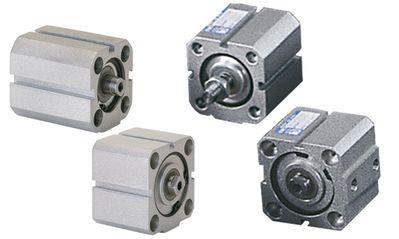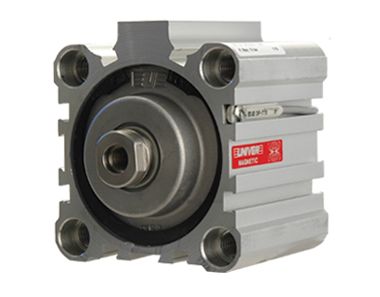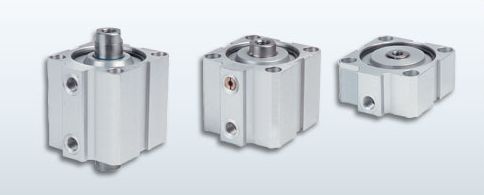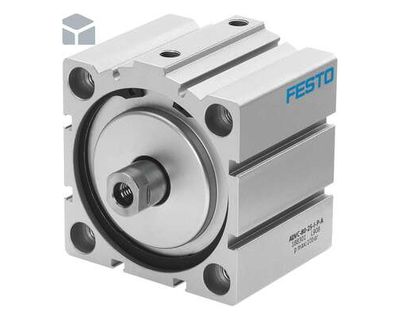Short stroke cylinders working principle
17.01.2023
Short stroke cylinders are used in the organization of auxiliary control units. The devices have high positioning accuracy and provide delicate adjustment of equipment connected to the network. Today we will take a closer look at compact short stroke pneumatic cylinders.
What is a Short Stroke Cylinder?
Short stroke hydraulic cylinders are double-acting pneumatic cylinders with a single-sided piston rod. Designed to convert compressed air energy into mechanical linear movement in pneumatic systems. The small dimensions of pneumatic cylinders make it possible to use them in the creation of compact units of equipment.
The product is made in a durable stainless steel case. In its end part, there are threaded holes that simplify the placement of products on the carrier plane.
Modules with a small stroke of the rod are in demand in most enterprises. They are used in the food industry, and are indispensable on assembly lines for the assembly of complex equipment.
Features of short stroke cylinders:
- quick and easy setup;
- compatibility with a wide range of lines;
- minimum maintenance costs;
- significant time to failure;
- resistance to temperature changes;
- possibility of operation in a humid environment.
Short-stroke cylinders by design, almost repeat the standard ones. These cylinders differ only in their narrow bonnets, narrow piston, and short bearing sleeve. Short strokes do not have caps. The body is made of an aluminum profile in the form of a blind sleeve. From the rod side, the cylinder is closed by a disk with a spring ring.
There are two types of short-stroke cylinders: single-acting - which has one port for stroke in one direction and double-acting - which has two ports for stroke in two directions.
The short stroke air cylinders consist of the:
- back cover;
- piston;
- seal;
- stock;
- sleeve;
- return spring;
- filter element;
- front cover;
- sleeve.
In a device of this type, the sleeve of the pneumatic cylinder is closed on both sides with covers. The back cover has a hole for compressed air supply. The front cover has a decompression opening with a built-in filter element. The piston divides the inner space of the sleeve into two cavities: rod and piston. The cavities are delimited by a hermetic seal. It is located in an annular groove on the outer cylindrical surface of the piston. The front cover is equipped with a guide sleeve. This sleeve is the sliding support of the stem. It transfers the force from the piston to an external object. The return spring is mounted inside the cylinder and covers the rod.
The double-acting pneumatic cylinder in composition and method of fastening practically does not differ from single-acting devices. The only difference is this. In double-acting pneumatic cylinders, the forward and reverse strokes of the piston are carried out under the action of compressed air with its alternating supply to one of the cavities.
What is the advantage of a short-stroke engine?
The cylinder diameter of an engine is the diameter of each cylinder, and the stroke of the piston is the distance inside the cylinder that the piston travels. Essentially, the maximum power of an engine depends on how many revolutions it can reach. The more revolutions per minute, the more working strokes, and the more power it produces overall. Thus, it makes sense that the most powerful engines also have the highest RPMs.
An average stroke piston doesn't have to move that far per cycle each time, it can shorten a greater distance at the same time compared to an engine with a longer stroke and a longer cylinder stroke. This means more revolutions. Likewise, more bore means bigger valves, which means it can suck in and out more air each cycle. And more air means more power.
Short stroke cylinders working principle
Piston short stroke cylinders are actuators for converting the energy of compressed air into reciprocating movement of the rod.
Compressed air from a compressor or other source is supplied to the piston cavity of the pneumatic cylinder, the rod cavity at this moment is connected to the atmosphere with the help of a distributor, and the pressure of compressed air acts on the piston, causing it to move until it rests against the front cover.
The pneumatic cylinder makes a straight stroke, and its rod extends. To carry out the reverse stroke, it is necessary to supply compressed air to the rod end, and the piston end to be connected to the atmosphere. Under the action of compressed air pressure, the piston will move, and the rod will move.
The direction of compressed air flows into the piston and rod cavities, as well as their connection with the atmosphere or the discharge line, is carried out using special devices - pneumatic distributors.
In single-acting pneumatic cylinders, compressed air is supplied only to one cavity, the reverse stroke is carried out due to a spring, or under the action of an external influence.
The dimensions of the effective areas and the volumes of the cavities during the forward and reverse strokes of the pneumatic cylinder are different. This means that other things being equal, the pneumatic cylinder will move at different speeds and create different forces during forward and reverse strokes. This is not always desirable.
If the pneumatic cylinder must act in the same way both in forward and reverse stroke, then a pneumatic cylinder with a double-sided rod is used. In pneumatic actuators, designs with a fixed sleeve or with a fixed stem are used. In the second case, compressed air is supplied to the working cavities through the rod.